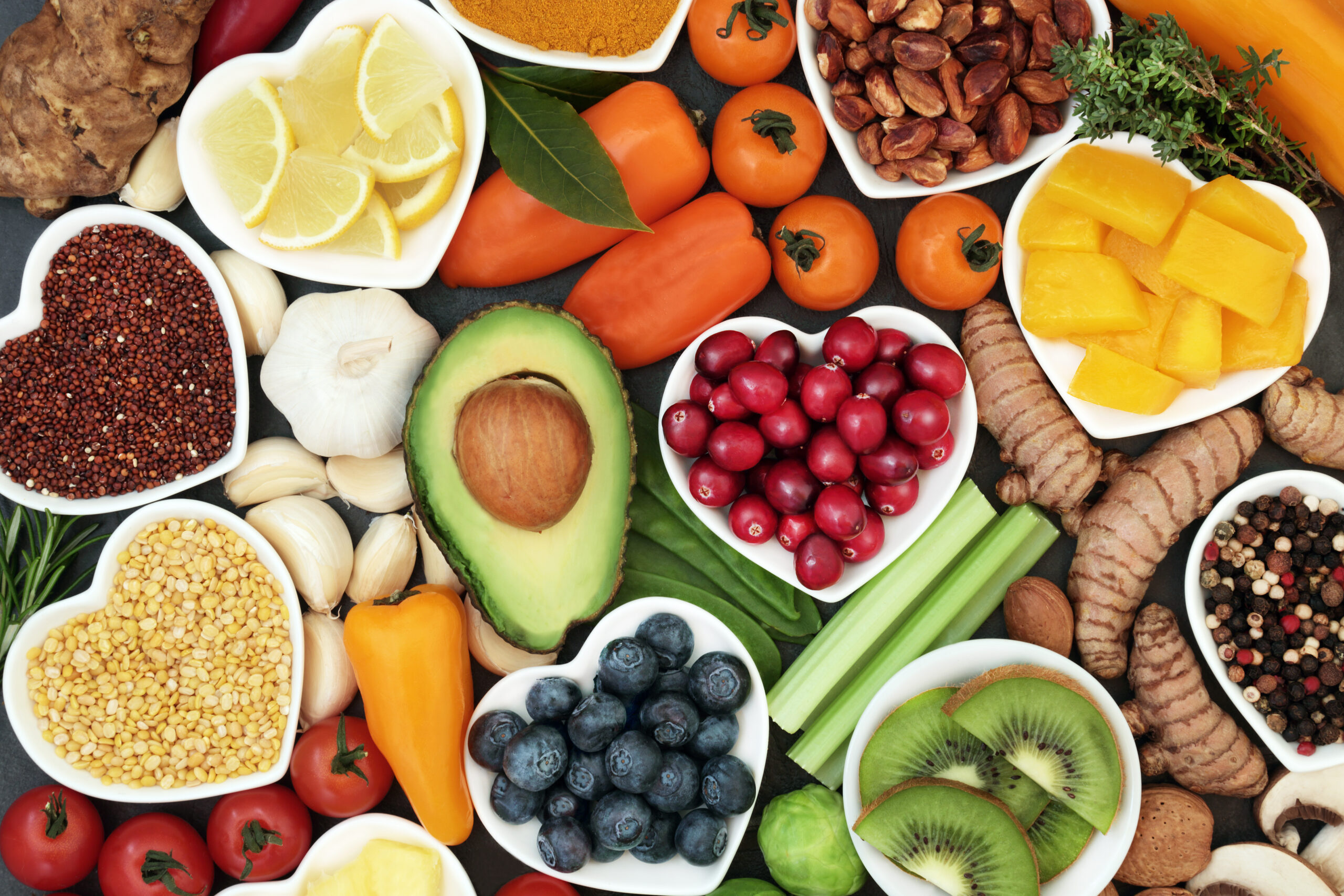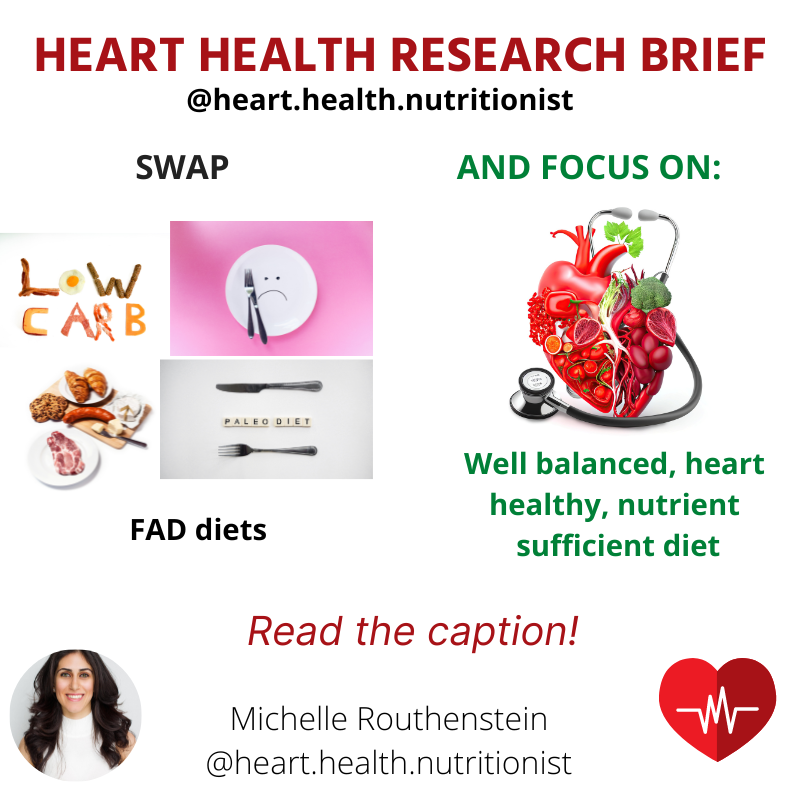Food is directly involved in many of the risk factors for cardiovascular disease (CVD). Fortunately, a vast amount of research shows that most cases of CVD can easily be prevented with diet. That’s why I’m such a big advocate for science-based nutrition because it works.
A cardiac diet that is personalized for long-term sustainability is a key factor in prevention. This way of eating is nutrient-dense, has tons of variety, and is full of foods with heart-protective benefits.
What does a healthy cardiac diet look like? Stick around to find out the top foods bad for the heart and how to replace them with foods good for your heart.
How Can I Prevent Heart Disease?
Examining what you’re currently eating (and identifying areas for improvement) is a great first step in lowering your risk of heart disease. Here are a few practical recommendations for designing a cardiac diet that includes foods good for your heart.
Eat More Fruits and Vegetables
High consumption of fruits and vegetables, which are abundant in antioxidants (compounds that protect your cellular health from damaging stress and disease), potassium, nitric oxide, B vitamins, and fiber positively impact blood flow and blood vessel function. This makes them essential players in an optimal cardiac diet.
Refined Grains Out, Whole Grains In
Whole grains are a simple way to boost your intake of fiber and other important nutrients, such as folate, thiamine, and niacin, which are cardioprotective. On the other hand, ultra-processed refined grains fall into the category of foods to avoid for heart health.
In one meta-analysis, individuals who ate three daily servings of whole grains had a 25-36% reduced risk of heart disease and a 37% reduced risk of stroke.
Here are some easy swaps you can make:
- Brown rice instead of white rice
- 100% whole wheat bread instead of white bread
- Whole grain pasta instead of white pasta
- Add quinoa, teff, barley, oats, millet, and amaranth into your diet pattern
Increase Anti-Inflammatory Foods
Many foods that help fight inflammation contain omega-3 fatty acids. Omega-3 consumption is associated with a lower incidence of coronary artery disease and stroke by reducing inflammation, as well as lowering triglyceride levels, blood pressure, and resting heart rate.
Some great examples of omega-3-rich foods include:
- Fatty fish, like salmon, tuna, halibut, and mackerel
- Walnuts
- Chia and ground flax seeds
- Algae-derived omega-3 supplements if you don’t consume fish
Eat More Prebiotic and Probiotic Foods
An imbalance of our gut microbiome (the community of microbes living in your digestive tract) is now recognized as a CVD risk factor. When there are more harmful microbes than beneficial ones, this increases your risk of hypertension, hyperlipidemia, and associated cardiac illnesses.
Prebiotics and probiotics help rebalance our gut microbiota. A balanced gut can significantly reduce LDL and total cholesterol, and improve other CVD risk factors, such as inflammation and arterial function. This doesn’t mean you have to take supplements, as there are plenty of foods good for your heart that are also naturally rich in prebiotics and probiotics:
- Yogurt and kefir
- Sauerkraut
- Tempeh
- Miso
- Jerusalem artichoke
- Bananas and apples
Reduce Calories (in a Non-Restrictive Way)
By reducing the consumption of excess ‘empty’ calories (foods and beverages that contribute calories to your diet without beneficial nutrients), we make room for more nutrient-dense foods to help you feel satiated and help control your weight.
I strive to ensure my clients are never hungry during their diet adjustment, as restriction can lead to a slower metabolism and overall sabotage. It’s not only about removing foods that are harmful to your heart health but adding foods that your heart loves.
Limit Added Sugar
Limit your consumption of added sugar and sugar-sweetened beverages. Added sugar is among the foods to avoid for heart health as it has no nutritional value and can have a pro-inflammatory effect on your body which contributes to weight gain, type 2 diabetes, fatty liver disease, metabolic syndrome, and heart disease.
According to the American Heart Association, the daily limit for added sugar is about 6 teaspoons (25 grams) for women and 9 teaspoons (37 grams) for men. For reference, one can of regular soda can contain 40 grams of added sugar, so be sure to read food labels.
Reduce Meat Intake
Diets rich in meat, especially red and processed meats (like hot dogs, bacon, and sausage), have been associated with an increased risk of developing CVD and stroke. This is because they’re typically high in sodium, nitrate, and saturated fat, which are known to clog arteries.
Additionally, when meat is digested, it creates a substance called trimethylamine N-oxide (TMAO), which is linked to a higher risk of CVD.
Replace Saturated and Trans Fats with Unsaturated Fats
Animal foods like meat, poultry, eggs, and dairy products are high in saturated and naturally-occurring trans fats. While most plant foods are free from saturated fat, coconut and palm oils are an exception.
Instead of eating foods that don’t support your heart health, replace them with things like extra virgin cold-pressed olive oil, avocado oil, seeds, and nuts. Substituting unsaturated fats in place of saturated and trans fats reduces total and LDL cholesterol, as well as CVD risk and death.
Limit Sodium Intake
The main reason for limiting sodium intake is its effect on blood pressure. However, it also has serious implications for kidney and blood vessel health.
Try to limit your intake to 1,500 mg of sodium per day and be mindful of hidden sources of sodium, like canned, packaged, and frozen foods bad for the heart. Read nutrition facts labels to help.
Why Personalized Nutrition Matters
A one-size-fits-all approach to treat or prevent CVD is inadequate. Dietary requirements differ not only between the different types of CVD but also between different people.
A personalized and tailored approach will provide you with far greater benefits and long-lasting results. It takes into account your individual makeup, lifestyle factors, personal preferences, comorbidities, and other personal details related to each specific cardiovascular disorder.
What Should I Do Now?
A cardiac diet is not only key to preventing CVD and its complications, but it is also necessary for a long and healthy life. Changing your diet to remove foods to avoid for heart health can be extremely challenging without the right resources and support, so the correct guidance and counseling are critical for success.
With my background as a preventive cardiology dietitian, registered dietitian nutritionist, and certified diabetes educator, my passion lies in creating comprehensive and personalized lifestyle plans to enhance your well-being and quality of life.
To learn more about how I can help support you on your heart health journey, check out my 1 on 1 counseling page and my 6 week heart optimization group program. Feel free to email me with any questions or to learn more (michelle@entirelynourished.com), or schedule a 15-minute complimentary discovery call here.
References
- Aune, D., Giovannucci, E., Boffetta, P., Fadnes, L. T., Keum, N., Norat, T., Greenwood, D. C., Riboli, E., Vatten, L. J., & Tonstad, S. (2017). Fruit and vegetable intake and the risk of cardiovascular disease, total cancer and all-cause mortality-a systematic review and dose-response meta-analysis of prospective studies. International Journal of Epidemiology, 46(3), 1029–1056.
- Aune, D., Keum, N., Giovannucci, E., Fadnes, L. T., Boffetta, P., Greenwood, D. C., Tonstad, S., Vatten, L. J., Riboli, E., & Norat, T. (2016). Whole grain consumption and risk of cardiovascular disease, cancer, and all cause and cause specific mortality: systematic review and dose-response meta-analysis of prospective studies. BMJ , 353, i2716.
- Elagizi, A., Lavie, C. J., O’Keefe, E., Marshall, K., O’Keefe, J. H., & Milani, R. V. (2021). An Update on Omega-3 Polyunsaturated Fatty Acids and Cardiovascular Health. Nutrients, 13(1). https://doi.org/10.3390/nu13010204
- Astudillo, A. A., & Mayrovitz, H. N. (2021). The Gut Microbiome and Cardiovascular Disease. Cureus, 13(4), e14519.
- DiRienzo, D. B. (2014). Effect of probiotics on biomarkers of cardiovascular disease: implications for heart-healthy diets. Nutrition Reviews, 72(1), 18–29.
- Pallazola, V. A., Davis, D. M., Whelton, S. P., Cardoso, R., Latina, J. M., Michos, E. D., Sarkar, S., Blumenthal, R. S., Arnett, D. K., Stone, N. J., & Welty, F. K. (2019). A Clinician’s Guide to Healthy Eating for Cardiovascular Disease Prevention. Mayo Clinic Proceedings. Innovations, Quality & Outcomes, 3(3), 251–267.
- Added Sugars. (n.d.). Www.heart.org. Retrieved April 24, 2024, from https://www.heart.org/en/healthy-living/healthy-eating/eat-smart/sugar/added-sugars
- Wang, D. D., Li, Y., Nguyen, X.-M., Ho, Y.-L., Hu, F. B., Willett, W. C., Wilson, P. W., Cho, K., Gaziano, J. M., Djoussé, L., & Million Veteran Program. (2024). Red Meat Intake and the Risk of Cardiovascular Diseases: A Prospective Cohort Study in the Million Veteran Program. The Journal of Nutrition, 154(3), 886–895.
- Red meat, TMAO, and your heart. (2019, September 1). Harvard Health. https://www.health.harvard.edu/staying-healthy/red-meat-tmao-and-your-heart
- Maki, K. C., Dicklin, M. R., & Kirkpatrick, C. F. (2021). Saturated fats and cardiovascular health: Current evidence and controversies. Journal of Clinical Lipidology, 15(6), 765–772.

